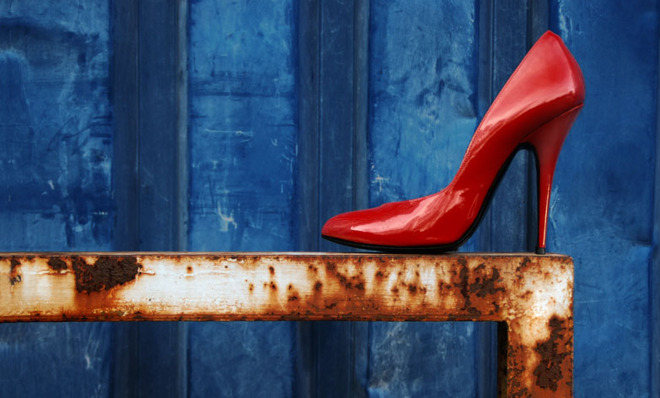A brief, scandalous history of high heels
How a standard footwear for 16th-century Persian horsemen became "fashion's most provocative accessory"


America's baroness of burlesque, Dita Von Teese, once said, "Heels and red lipstick will put the fear of God into people." It's a formidable quote that evokes a familiar image seen countless times in fashion magazines and Hollywood movies. It also attributes a great deal of power to a piece of footwear.
Last month, the Brooklyn Museum launched a new exhibit called Killer Heels: The Art of the High-Heeled Shoe, which deems the item "fashion's most provocative accessory." Spanning the course of several centuries — "from sixteenth-century Venetian platforms to twenty-first-century Christian Louboutins" — the show features over 160 heels designed by the likes of Vivienne Westwood, Alexander McQueen, Manolo Blahnik, and plenty of others. While the exhibit explores the history of shoes, it also explores the history of status, fantasy, innovation, beauty, and sex as told through shoes. "Fashion is a form of material culture that can reveal quite a bit about the personal, social, and cultural concerns of the era it comes from," Lisa Small, the museum's curator of exhibitions, told Forbes.
While all this may be true, heels also imply pain. In a sense, it's kind of amazing that an item that exemplifies the fashion-over-function ethos so fully has lasted for so long. Indeed, research suggests that long-term high heel use can both "compromise muscle efficiency" and "increase the risk of strain injuries." A recent survey conducted by the U.K.'s College of Podiatry found that, when in stilettos, most women's feet tend to start hurting after just one hour and six minutes. Furthermore, one in three women admit to walking home shoeless due to the relentless throbbing.
The Week
Escape your echo chamber. Get the facts behind the news, plus analysis from multiple perspectives.

Sign up for The Week's Free Newsletters
From our morning news briefing to a weekly Good News Newsletter, get the best of The Week delivered directly to your inbox.
From our morning news briefing to a weekly Good News Newsletter, get the best of The Week delivered directly to your inbox.
Hoping to take advantage of this — or less cynically, to provide some comfort — a couple of companies have created flats-dispensing vending machines to be stationed at various bars and night clubs. "People like things that are convenient," says Ashley Ross, U.S. director of operations at Rollasole, which has 13 machines stationed throughout Las Vegas. "Here, girls want to look good. They're not thinking about, 'Oh, my feet are going to hurt tonight.'"
Despite all the suffering and creative lengths some entrepreneurs go to relieve it, The Wall Street Journal reports that in 2011 women spent $38.5 billion on shoes in the U.S., with more than half of those sales going toward stilettos over three inches high.
"You could just as easily ask men why they wear neckties, which aren't particularly comfortable," Small told The Daily Beast when discussing the complicated act of willfully wearing something that brings about infliction. "The necktie has a universal currency of power whereas the high heel doesn't. It's too bound up in sexualization and objectification. Yet many women enjoy wearing them because they want to look conventionally sexy or because they like the confidence that comes with extra height."
Interestingly, it used to be men who wore the heels. For centuries, horseback riders in the East used them to provide balance when standing up in the stirrups (just like today's cowboy boots). The style eventually moved to Western Europe, where aristocrats embraced the footwear — not for its practicality, but to set themselves apart from the lower-class workers. A painting from 1701, for example, shows Louis XIV of France posing rather regally in a pair of red-heeled shoes. According to W magazine, when Napoleon Bonaparte crowned himself emperor in 1804, he decided to wear flats. The result: "The tiny general's gesture marked the end of an era, not only of monarchist rule in France but also of high-heel male power-dressing throughout the Western world."
A free daily email with the biggest news stories of the day – and the best features from TheWeek.com
So when and why did women start donning the accessory? Elizabeth Semmelhack, author of Heights of Fashion: A History of the Elevated Shoe and senior curator at the Bata Shoe Museum in Toronto, believes the answer lies in mid-19th-century pornography, which used the recent invention of photography to disseminate images of naked women in heels. While this convergence of events infused the shoe with its erotic aura and modern feminine identity, these women didn't have to stand in a pair of stilettos for very long or move around that much.
In 2011, the New Yorker published a profile of French footwear designer Christian Louboutin, whose shoes contain a signature red sole and sell at a rate of over 500,000 pairs per year at prices ranging from $395 to $6,000. Louboutin doesn't have sympathy for those who complain about his products' lack of comfort.
"I hate the whole concept of comfort!" Louboutin told the New Yorker. "It's like when people say, 'Well, we're not really in love, but we're in a comfortable relationship.' You're abandoning a lot of ideas when you are too into comfort. 'Comfy' — that's one of the worst words!"
Napoleon might disagree.
Pacific Standard grapples with the nation's biggest issues by illuminating why we do what we do. For more on the science of society, sign up for its weekly email update or subscribe to its bimonthly print magazine.
More from Pacific Standard...


